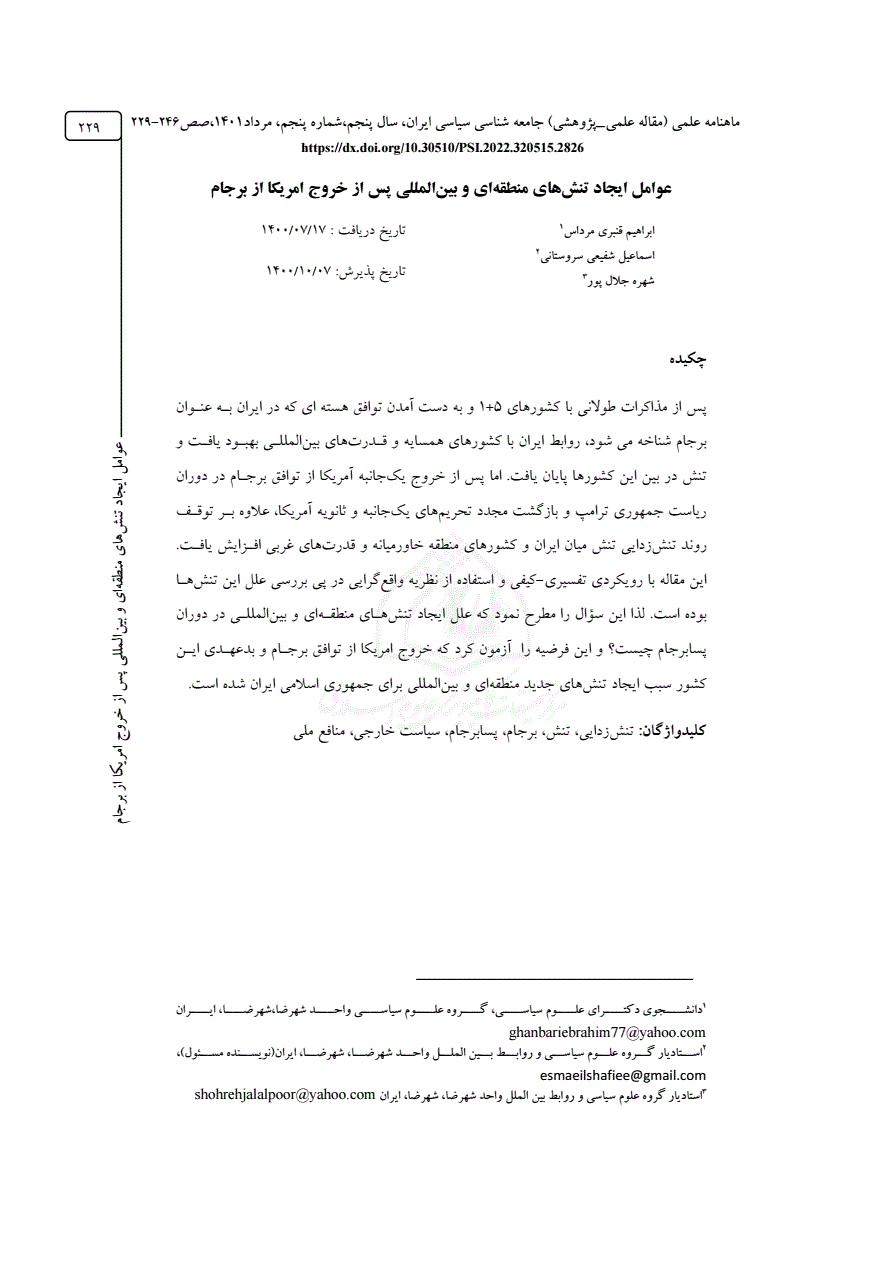چکیده:
موضوع این مقاله بررسی مولفه های تاثیرگذار بر ایجاد تنش های بین المللی و منطقه ای پس از برجام است. بنابراین سئوال تحقیق این است که علل ایجاد تنشهای منطقهای و بینالمللی در دوران پسابرجام چیست؟ و این فرضیه را به آزمون میگذارد که که خروج امریکا از توافق برجام و بدعهدی این کشور سبب ایجاد تنشهای جدید منطقهای و بینالمللی برای جمهوری اسلامی ایران شده است. نتایج تحقیق نشان می دهد که پس از خروج یکجانبه آمریکا از توافق برجام در دوران ریاست جمهوری ترامپ و بازگشت مجدد تحریمهای یکجانبه و ثانویه آمریکا، علاوه بر توقف روند تنشزدایی تنش میان ایران و کشورهای منطقه خاورمیانه و قدرتهای غربی افزایش یافت. بنابراین عدم پایبندی امریکا به یک معاهده بین المللی منجر به آنارشی در سطح منطقه ای و جهانی و تنش در روابط کشورها با همدیگر شده است. روش تحقیق در این مقاله، کیفی از نوع توصیفی-تحلیلی است و داده ها به شیوه کتابخانه ای و با استفاده از فیش برداری گردآوری شده اند.
The subject of this article is to examine the components affecting the creation of international and regional tensions after JCPOA. So the research question is what are the causes of regional and international tensions in the post-conflict period? And it tests the hypothesis that the US withdrawal from the JCPOA and its inaction has created new regional and international tensions for the Islamic Republic of Iran. The results of the study show that after the US unilateral withdrawal from the JCPOA agreement during Trump's presidency and the return of US unilateral and secondary sanctions, in addition to stopping the process of de-escalation, tensions between Iran and the Middle East and Western powers increased. Thus, the United States' non-compliance with an international treaty has led to regional and global anarchy and tensions between countries. The research method in this article is descriptive-analytical qualitative and the data are collected in a library method using phishing.
خلاصه ماشینی:
لذا اين سؤال را مطرح نمود که علل ايجاد تنش هـاي منطقـه اي و بين المللـي در دوران پسابرجام چيست ؟ و اين فرضيه را آزمون کرد که خروج امريکا از توافق برجـام و بدعهـدي ايـن کشور سبب ايجاد تنش هاي جديد منطقه اي و بين المللي براي جمهوري اسلامي ايران شده است .
ا. ايـران از دهه ٨٠ تاکنون ، ماهنامه پژوهش ملل / دوره دوم ، شماره ٢٤ مينويسد: سياست خارجي بـه عنوان مجموعه خط و مشيها، تدابير، روش ها و انتخاب مواضعي کـه يـک دولـت در برخـورد بـا امـور مسائل خارجي در چارچوب اهداف کلي نظام سياسي اعمال مينمايد، بـر اصـولي ثابـت و پايـدار استوار است که در عرصه هاي بين المللي راهنماي رفتار و کنش سياسـت خـارجي قـرار ميگيرنـد.
"(٢٠١٩ ,٨ trump, April) - از تاريخ ٢ مه ٢٠١٩ ، دولت به استثناي تحريم هاي ايالات متحده براي خريد هر کشور بـراي خريـد نفت ايران خاتمه داد، با هـدف ايـن کـه صـادرات نفـت ايـران را بـه "صـفر" برسـاند.
(٢٠١٩ ,١٨ Bloomberg, August ) ظاهراً اين کشتي با وجود تعهد، نفت خود را به سوريه تحويل داده و درنتيجه ، ايالات متحده تحريم هاي جديدي را براي افراد و اشخاص مرتبط با کشـتي و شـبکه کشـتيراني ايـران وضـع کـرده اسـت کـه وزارت خزانه داري به عنوان کمک کننده به آن و ساير نفت ايران معرفي کرده است .

(پژوهیار,
,
,
)

